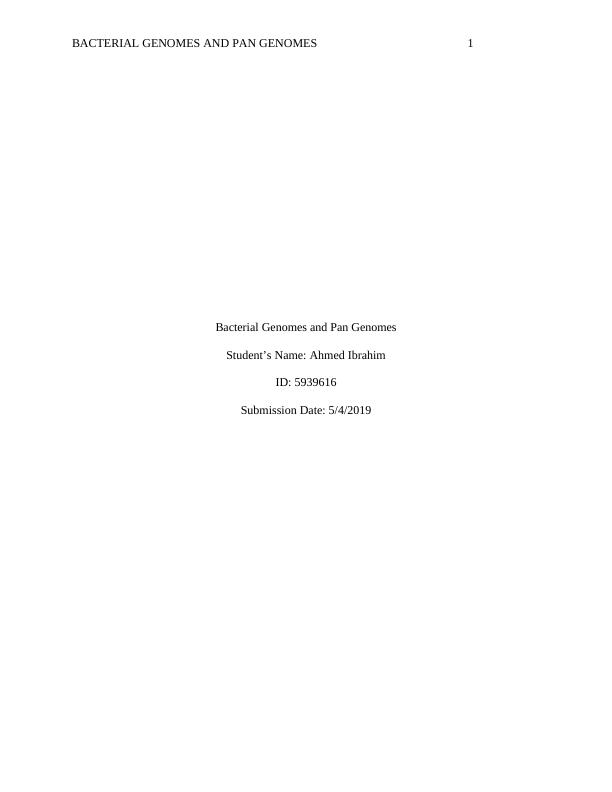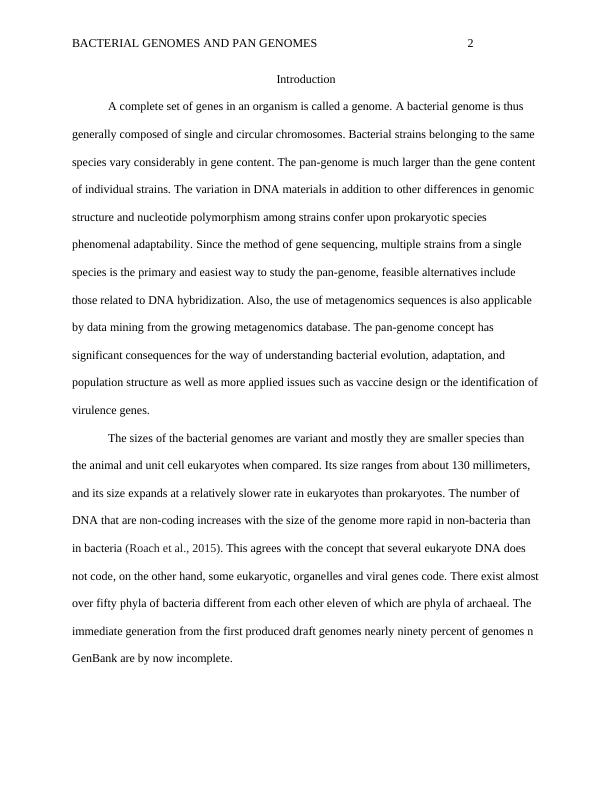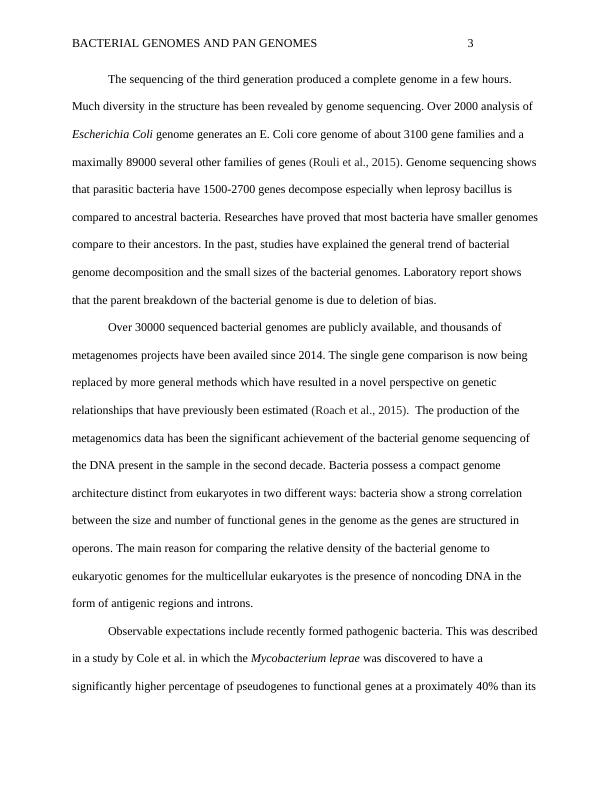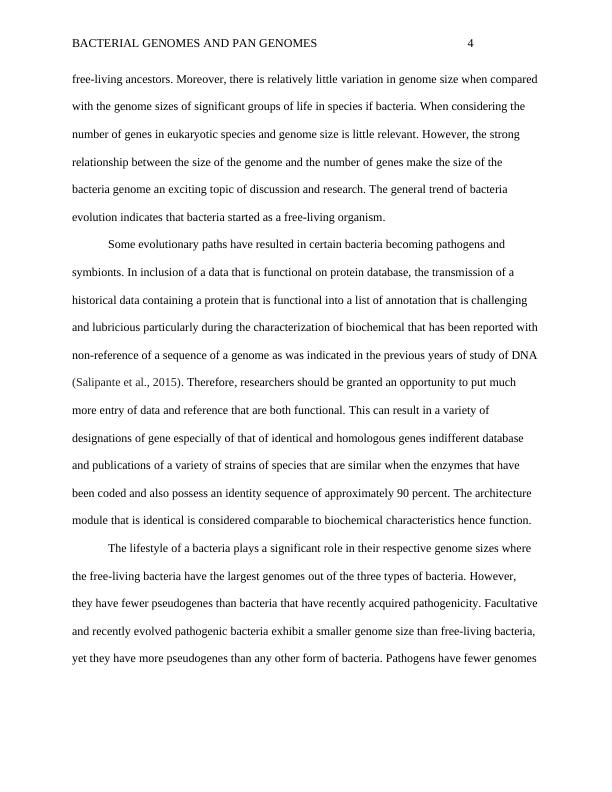Bacterial Genomes and Pan Genomes
Added on 2023-01-16
13 Pages3945 Words85 Views
BACTERIAL GENOMES AND PAN GENOMES 1
Bacterial Genomes and Pan Genomes
Student’s Name: Ahmed Ibrahim
ID: 5939616
Submission Date: 5/4/2019
Bacterial Genomes and Pan Genomes
Student’s Name: Ahmed Ibrahim
ID: 5939616
Submission Date: 5/4/2019

BACTERIAL GENOMES AND PAN GENOMES 2
Introduction
A complete set of genes in an organism is called a genome. A bacterial genome is thus
generally composed of single and circular chromosomes. Bacterial strains belonging to the same
species vary considerably in gene content. The pan-genome is much larger than the gene content
of individual strains. The variation in DNA materials in addition to other differences in genomic
structure and nucleotide polymorphism among strains confer upon prokaryotic species
phenomenal adaptability. Since the method of gene sequencing, multiple strains from a single
species is the primary and easiest way to study the pan-genome, feasible alternatives include
those related to DNA hybridization. Also, the use of metagenomics sequences is also applicable
by data mining from the growing metagenomics database. The pan-genome concept has
significant consequences for the way of understanding bacterial evolution, adaptation, and
population structure as well as more applied issues such as vaccine design or the identification of
virulence genes.
The sizes of the bacterial genomes are variant and mostly they are smaller species than
the animal and unit cell eukaryotes when compared. Its size ranges from about 130 millimeters,
and its size expands at a relatively slower rate in eukaryotes than prokaryotes. The number of
DNA that are non-coding increases with the size of the genome more rapid in non-bacteria than
in bacteria (Roach et al., 2015). This agrees with the concept that several eukaryote DNA does
not code, on the other hand, some eukaryotic, organelles and viral genes code. There exist almost
over fifty phyla of bacteria different from each other eleven of which are phyla of archaeal. The
immediate generation from the first produced draft genomes nearly ninety percent of genomes n
GenBank are by now incomplete.
Introduction
A complete set of genes in an organism is called a genome. A bacterial genome is thus
generally composed of single and circular chromosomes. Bacterial strains belonging to the same
species vary considerably in gene content. The pan-genome is much larger than the gene content
of individual strains. The variation in DNA materials in addition to other differences in genomic
structure and nucleotide polymorphism among strains confer upon prokaryotic species
phenomenal adaptability. Since the method of gene sequencing, multiple strains from a single
species is the primary and easiest way to study the pan-genome, feasible alternatives include
those related to DNA hybridization. Also, the use of metagenomics sequences is also applicable
by data mining from the growing metagenomics database. The pan-genome concept has
significant consequences for the way of understanding bacterial evolution, adaptation, and
population structure as well as more applied issues such as vaccine design or the identification of
virulence genes.
The sizes of the bacterial genomes are variant and mostly they are smaller species than
the animal and unit cell eukaryotes when compared. Its size ranges from about 130 millimeters,
and its size expands at a relatively slower rate in eukaryotes than prokaryotes. The number of
DNA that are non-coding increases with the size of the genome more rapid in non-bacteria than
in bacteria (Roach et al., 2015). This agrees with the concept that several eukaryote DNA does
not code, on the other hand, some eukaryotic, organelles and viral genes code. There exist almost
over fifty phyla of bacteria different from each other eleven of which are phyla of archaeal. The
immediate generation from the first produced draft genomes nearly ninety percent of genomes n
GenBank are by now incomplete.

BACTERIAL GENOMES AND PAN GENOMES 3
The sequencing of the third generation produced a complete genome in a few hours.
Much diversity in the structure has been revealed by genome sequencing. Over 2000 analysis of
Escherichia Coli genome generates an E. Coli core genome of about 3100 gene families and a
maximally 89000 several other families of genes (Rouli et al., 2015). Genome sequencing shows
that parasitic bacteria have 1500-2700 genes decompose especially when leprosy bacillus is
compared to ancestral bacteria. Researches have proved that most bacteria have smaller genomes
compare to their ancestors. In the past, studies have explained the general trend of bacterial
genome decomposition and the small sizes of the bacterial genomes. Laboratory report shows
that the parent breakdown of the bacterial genome is due to deletion of bias.
Over 30000 sequenced bacterial genomes are publicly available, and thousands of
metagenomes projects have been availed since 2014. The single gene comparison is now being
replaced by more general methods which have resulted in a novel perspective on genetic
relationships that have previously been estimated (Roach et al., 2015). The production of the
metagenomics data has been the significant achievement of the bacterial genome sequencing of
the DNA present in the sample in the second decade. Bacteria possess a compact genome
architecture distinct from eukaryotes in two different ways: bacteria show a strong correlation
between the size and number of functional genes in the genome as the genes are structured in
operons. The main reason for comparing the relative density of the bacterial genome to
eukaryotic genomes for the multicellular eukaryotes is the presence of noncoding DNA in the
form of antigenic regions and introns.
Observable expectations include recently formed pathogenic bacteria. This was described
in a study by Cole et al. in which the Mycobacterium leprae was discovered to have a
significantly higher percentage of pseudogenes to functional genes at a proximately 40% than its
The sequencing of the third generation produced a complete genome in a few hours.
Much diversity in the structure has been revealed by genome sequencing. Over 2000 analysis of
Escherichia Coli genome generates an E. Coli core genome of about 3100 gene families and a
maximally 89000 several other families of genes (Rouli et al., 2015). Genome sequencing shows
that parasitic bacteria have 1500-2700 genes decompose especially when leprosy bacillus is
compared to ancestral bacteria. Researches have proved that most bacteria have smaller genomes
compare to their ancestors. In the past, studies have explained the general trend of bacterial
genome decomposition and the small sizes of the bacterial genomes. Laboratory report shows
that the parent breakdown of the bacterial genome is due to deletion of bias.
Over 30000 sequenced bacterial genomes are publicly available, and thousands of
metagenomes projects have been availed since 2014. The single gene comparison is now being
replaced by more general methods which have resulted in a novel perspective on genetic
relationships that have previously been estimated (Roach et al., 2015). The production of the
metagenomics data has been the significant achievement of the bacterial genome sequencing of
the DNA present in the sample in the second decade. Bacteria possess a compact genome
architecture distinct from eukaryotes in two different ways: bacteria show a strong correlation
between the size and number of functional genes in the genome as the genes are structured in
operons. The main reason for comparing the relative density of the bacterial genome to
eukaryotic genomes for the multicellular eukaryotes is the presence of noncoding DNA in the
form of antigenic regions and introns.
Observable expectations include recently formed pathogenic bacteria. This was described
in a study by Cole et al. in which the Mycobacterium leprae was discovered to have a
significantly higher percentage of pseudogenes to functional genes at a proximately 40% than its

BACTERIAL GENOMES AND PAN GENOMES 4
free-living ancestors. Moreover, there is relatively little variation in genome size when compared
with the genome sizes of significant groups of life in species if bacteria. When considering the
number of genes in eukaryotic species and genome size is little relevant. However, the strong
relationship between the size of the genome and the number of genes make the size of the
bacteria genome an exciting topic of discussion and research. The general trend of bacteria
evolution indicates that bacteria started as a free-living organism.
Some evolutionary paths have resulted in certain bacteria becoming pathogens and
symbionts. In inclusion of a data that is functional on protein database, the transmission of a
historical data containing a protein that is functional into a list of annotation that is challenging
and lubricious particularly during the characterization of biochemical that has been reported with
non-reference of a sequence of a genome as was indicated in the previous years of study of DNA
(Salipante et al., 2015). Therefore, researchers should be granted an opportunity to put much
more entry of data and reference that are both functional. This can result in a variety of
designations of gene especially of that of identical and homologous genes indifferent database
and publications of a variety of strains of species that are similar when the enzymes that have
been coded and also possess an identity sequence of approximately 90 percent. The architecture
module that is identical is considered comparable to biochemical characteristics hence function.
The lifestyle of a bacteria plays a significant role in their respective genome sizes where
the free-living bacteria have the largest genomes out of the three types of bacteria. However,
they have fewer pseudogenes than bacteria that have recently acquired pathogenicity. Facultative
and recently evolved pathogenic bacteria exhibit a smaller genome size than free-living bacteria,
yet they have more pseudogenes than any other form of bacteria. Pathogens have fewer genomes
free-living ancestors. Moreover, there is relatively little variation in genome size when compared
with the genome sizes of significant groups of life in species if bacteria. When considering the
number of genes in eukaryotic species and genome size is little relevant. However, the strong
relationship between the size of the genome and the number of genes make the size of the
bacteria genome an exciting topic of discussion and research. The general trend of bacteria
evolution indicates that bacteria started as a free-living organism.
Some evolutionary paths have resulted in certain bacteria becoming pathogens and
symbionts. In inclusion of a data that is functional on protein database, the transmission of a
historical data containing a protein that is functional into a list of annotation that is challenging
and lubricious particularly during the characterization of biochemical that has been reported with
non-reference of a sequence of a genome as was indicated in the previous years of study of DNA
(Salipante et al., 2015). Therefore, researchers should be granted an opportunity to put much
more entry of data and reference that are both functional. This can result in a variety of
designations of gene especially of that of identical and homologous genes indifferent database
and publications of a variety of strains of species that are similar when the enzymes that have
been coded and also possess an identity sequence of approximately 90 percent. The architecture
module that is identical is considered comparable to biochemical characteristics hence function.
The lifestyle of a bacteria plays a significant role in their respective genome sizes where
the free-living bacteria have the largest genomes out of the three types of bacteria. However,
they have fewer pseudogenes than bacteria that have recently acquired pathogenicity. Facultative
and recently evolved pathogenic bacteria exhibit a smaller genome size than free-living bacteria,
yet they have more pseudogenes than any other form of bacteria. Pathogens have fewer genomes

End of preview
Want to access all the pages? Upload your documents or become a member.
Related Documents
Bacterial Genomes and Pan Genomeslg...
|13
|3941
|463
(PDF) Horizontal Gene Transferlg...
|7
|1372
|39
The Story Behind the Eukaryotic Origin | Essaylg...
|4
|612
|23
Biology Taskslg...
|36
|8608
|101